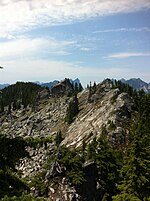Mount Baker–Snoqualmie National Forest
1974 establishments in Washington (state)Mount Baker-Snoqualmie National ForestNational Forests of Washington (state)North Cascades of Washington (state)Protected areas established in 1974 ... and 6 more
Protected areas of King County, WashingtonProtected areas of Kittitas County, WashingtonProtected areas of Pierce County, WashingtonProtected areas of Skagit County, WashingtonProtected areas of Snohomish County, WashingtonProtected areas of Whatcom County, Washington

The Mount Baker–Snoqualmie National Forest in Washington is a National Forest extending more than 140 miles (230 km) along the western slopes of the Cascade Range from the Canada–US border to the northern boundary of Mount Rainier National Park. Administered by the United States Forest Service, the forest is headquartered in Everett. There are local ranger district offices in North Bend and Skykomish.
Excerpt from the Wikipedia article Mount Baker–Snoqualmie National Forest (License: CC BY-SA 3.0, Authors, Images).Mount Baker–Snoqualmie National Forest
Ludwigsburger Straße, Gemeindeverwaltungsverband Steinheim-Murr
Geographical coordinates (GPS) Address Nearby Places Show on map
Geographical coordinates (GPS)
| Latitude | Longitude |
|---|---|
| N 47.766 ° | E -121.378 ° |
Address
Ludwigsburger Straße 2
71711 Gemeindeverwaltungsverband Steinheim-Murr
Baden-Württemberg, Deutschland
Open on Google Maps






